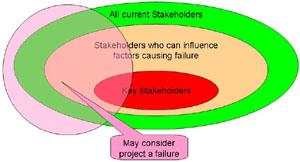I have been putting the hard yards into finishing my new book on Stakeholder Relationship Management Maturity (SRMM®) over the holiday period and have been considering the relationship between success and stakeholders.
One potential conclusion is that success is gifted to you by your stakeholders, you have to earn the gift but there is no way of knowing for sure if it will be granted. This means as a project manager, sports person or business executive, you have to put the effort in to ‘win’ by delivering ‘on-time and on-budget’, finishing first or achieving the planned objective; but achievement on its own does not translate to success. Success is when your achievement is acknowledged by your key stakeholders and they declare it a ‘success’.
Some of the world’s most famous buildings were project management disasters, but they are now considered outstanding successes. The Sydney Opera House overran time, overran budget and the original scope not achieved. The London Eye needed an additional £48 million loan from British Airways to finance is construction in addition to the original capital raising and was months late in opening to the public (in 2005 BA sold its share of the project for £95m and waived £60m of unpaid interest).
Success seems to come from a combination of two factors. One is delivering something of real value to the stakeholder. The other is when a critical mass of key stakeholders recognises the value and appreciates it. Value is not a synonym for ‘on-time and on-budget’ these two factors only matter to the extent that they impact on the usefulness of the outcome when it’s actually used by the stakeholders. Certainly time and money may be important, more often they are not; particularly if a longer term view of benefits realisation is considered. Benefits are realised when the product is actually used and this requires the relevant stakeholder’s participation in actually using the product or output to achive the intended outcomes.
Another important factor in achieving success is meeting the stakeholder’s expectations. This involves identifying and managing their expectations (unrealistic expectations are unlikely to be fulfilled) which in turn requires effective two-way communication. But the stakeholder community for any business activity can be huge.

Three groups of Stakeholders
There are a vast number of potential stakeholders who you don’t know and can’t see. This group is often considered as ‘classes’ of stakeholder such as ‘the public’. The only way to reach individual people this group is through broadcasting messages in a similar way to a corporation advertising it brand image to a general audience. Businesses see this activity as Public Relations (PR) or Marketing. In project space, this is the casual audience for general project newsletters, headlines on a project web page and the corporations ‘rumour mill’.
A sub-set of the overall group are the people you know you need to positively influence. In business these groups are the focus of targeted advertising campaigns with specific ‘calls to action’. In project space they may be groups such as the end users of a new system. You need to ‘sell the benefits’ of the product or project to this group so they buy-in to the concept and appreciate the value of the outcome you are creating. There are still too many for one-on-one communication but a carefully planned ‘sales campaign’ associated with effective change management and similar initiatives are critical if you expect a successful outcome. Many of this group may be recipients of routine monthly reports and the like but more is needed; you need to create positive expectations and then deliver on them.
The smallest and most important group are the key stakeholders who wield significant influence or power. This group require targeted one-on-one communication to build and foster positive relationships. It’s a two way process, you need support from them, they need to appreciate the benefits your project or activity will deliver. The Stakeholder Circle® methodology and tools are focused on identifying the ‘right’ stakeholders at the ‘right’ time in a project for this critical communication activity. Failure with this group will generally cause your project to fail and before you can ‘win’ you first have to ‘not lose’!
However, the thought in this blog is these key people are probably not enough on their own to declare the final result of your efforts and outstanding success. Real success requires buy-in from a much larger group of stakeholders, such as the 30 million visitors who have ‘flown’ on the London Eye. But is your organisation mature enough to support the type of structured communication needed to achieve this level of success?
My SRMM® construct addresses the maturity of an organisation to engage in effective stakeholder relationship management and this is a critical start. The bigger question is who’s responsible for the wider communication: the project team, the change manager, the sponsor or the organisation? Achieving real success is definitely a lot more complex than just being on-time and on-budget…. Perhaps this could be the subject for another book?




